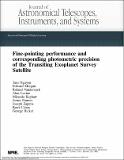Fine-pointing performance and corresponding photometric precision of the Transiting Exoplanet Survey Satellite
Author(s)
Nguyen, Tam T; Morgan, Edward H; Vanderspek, Roland K; Levine, Alan M; Kephart, Miranda E; Francis, James E; Zapetis, Joseph F; Cahoy, Kerri; Ricker, George R; ... Show more Show less
DownloadPublished version (4.021Mb)
Publisher with Creative Commons License
Publisher with Creative Commons License
Creative Commons Attribution
Additional downloads
Publisher Policy
Publisher Policy
Article is made available in accordance with the publisher's policy and may be subject to US copyright law. Please refer to the publisher's site for terms of use.
Terms of use
Metadata
Show full item recordAbstract
The Transiting Exoplanet Survey Satellite (TESS) is an MIT-led, NASA-funded Explorer-class planet finder launched in April 2018. TESS will carry out a 2-year all-sky survey with the primary goal of detecting small transiting exoplanets around bright and nearby stars. The TESS instrument consists of four wide-field cameras in a stacked configuration, providing a combined field of view of 24 deg × 96 deg that spans approximately from the ecliptic plane to the ecliptic pole. In order to achieve the desired photometric precision necessary for the mission, TESS uses the instrument cameras as star trackers during fine-pointing mode to enhance attitude accuracy and stabilization for science operations. We present our approach in quantifying the expected performance of the fine-pointing system and assessing the impact of pointing performance on the overall photometric precision of the mission. First, we describe the operational details of the fine-pointing system with the science instrument being used for star-tracking. Next, we present the testing framework used to quantify the attitude determination performance of the system and the expected attitude knowledge accuracy results, both in coarse-fine pointing hand-off and in nominal fine-pointing conditions. By combining simulations of the instrument and the spacecraft bus, we quantify the closed-loop fine-pointing stability performance of the system in nominal science operations as well as in the case of camera unavailability due to Earth/Moon interference. Finally, we assess the impact of platform pointing stability on the photometric precision of the system using detailed system modeling and discuss the applicability of mitigation techniques to reduce the effect of jitter on TESS science data.
Date issued
2018-09Department
Massachusetts Institute of Technology. Department of Aeronautics and Astronautics; MIT Kavli Institute for Astrophysics and Space ResearchJournal
Journal of Astronomical Telescopes, Instruments, and Systems
Publisher
Society of Photo-Optical Instrumentation Engineers (SPIE)
Citation
Nguyen, Tam et al. "Fine-pointing performance and corresponding photometric precision of the Transiting Exoplanet Survey Satellite." Journal of Astronomical Telescopes, Instruments, and Systems 4, 4 (September 2018): 047001 © 2018 The Authors
Version: Final published version
ISSN
2329-4124